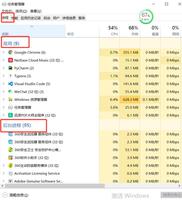Python流

流是用于处理网络连接的高级 async/await-ready 原语。流允许发送和接收数据,而不需要使用回调或低级协议和传输。
下面是一个使用 asyncio streams 编写的 TCP echo 客户端示例:
importasyncioasyncdeftcp_echo_client(message):
reader,writer=awaitasyncio.open_connection(
'127.0.0.1',8888)
print(f'Send: {message!r}')
writer.write(message.encode())
data=awaitreader.read(100)
print(f'Received: {data.decode()!r}')
print('Close the connection')
writer.close()
awaitwriter.wait_closed()
asyncio.run(tcp_echo_client('Hello World!'))
参见下面的 Examples 部分。
Stream 函数
下面的高级 asyncio 函数可以用来创建和处理流:
coroutine
asyncio.open_connection(host=None, port=None, *, loop=None, limit=None, ssl=None, family=0, proto=0, flags=0, sock=None, local_addr=None, server_hostname=None, ssl_handshake_timeout=None)¶建立网络连接并返回一对
(reader,writer)对象。返回的 reader 和 writer 对象是
StreamReader和StreamWriter类的实例。loop 参数是可选的,当从协程中等待该函数时,总是可以自动确定。
limit 确定返回的
StreamReader实例使用的缓冲区大小限制。默认情况下,limit 设置为 64 KiB 。其余的参数直接传递到
loop.create_connection()。3.7 新版功能: ssl_handshake_timeout 形参。
coroutine
asyncio.start_server(client_connected_cb, host=None, port=None, *, loop=None, limit=None, family=socket.AF_UNSPEC, flags=socket.AI_PASSIVE, sock=None, backlog=100, ssl=None, reuse_address=None, reuse_port=None, ssl_handshake_timeout=None, start_serving=True)¶启动套接字服务。
当一个新的客户端连接被建立时,回调函数 client_connected_cb 会被调用。该函数会接收到一对参数
(reader,writer),reader是类StreamReader的实例,而writer是类StreamWriter的实例。client_connected_cb 即可以是普通的可调用对象也可以是一个 协程函数; 如果它是一个协程函数,它将自动作为
Task被调度。loop 参数是可选的。当在一个协程中await该方法时,该参数始终可以自动确定。
limit 确定返回的
StreamReader实例使用的缓冲区大小限制。默认情况下,limit 设置为 64 KiB 。余下的参数将会直接传递给
loop.create_server().3.7 新版功能: The ssl_handshake_timeout and start_serving parameters.
Unix 套接字
coroutine
asyncio.open_unix_connection(path=None, *, loop=None, limit=None, ssl=None, sock=None, server_hostname=None, ssl_handshake_timeout=None)¶建立一个 Unix 套接字连接并返回
(reader,writer)这对返回值。与
open_connection()相似,但是操作在 Unix 套接字上请看文档
loop.create_unix_connection().可用性: Unix。
3.7 新版功能: ssl_handshake_timeout 形参。
在 3.7 版更改: path 现在是一个 path-like object
coroutine
asyncio.start_unix_server(client_connected_cb, path=None, *, loop=None, limit=None, sock=None, backlog=100, ssl=None, ssl_handshake_timeout=None, start_serving=True)¶启动一个Unix socket服务。
与
start_server()相似,但是是在 Unix 套接字上的操作。请看文档
loop.create_unix_server().可用性: Unix。
3.7 新版功能: The ssl_handshake_timeout and start_serving parameters.
在 3.7 版更改: path 形参现在可以是 path-like object 对象。
StreamReader¶
class
asyncio.StreamReader¶这个类表示一个提供api来从IO流中读取数据的读取器对象。
不推荐直接实例化 StreamReader 对象,建议使用
open_connection()和start_server()来获取 StreamReader 实例。coroutine
read(n=-1)¶读取 n 个byte. 如果没有设置 n , 则自动置为
-1,读至 EOF 并返回所有读取的byte。如果读到EOF,且内部缓冲区为空,则返回一个空的
bytes对象。
coroutine
readline()¶读取一行,其中“行”指的是以
\n结尾的字节序列。如果读到EOF而没有找到
\n,该方法返回部分读取的数据。如果读到EOF,且内部缓冲区为空,则返回一个空的
bytes对象。
coroutine
readexactly(n)¶精准读取 n 个 bytes,不能超过也不能少于。
如果在读取完 n 个byte之前读取到EOF,则会抛出
IncompleteReadError异常。使用IncompleteReadError.partial属性来获取到达流结束之前读取的 bytes 字符串。
coroutine
readuntil(separator=b'\n')¶从流中读取数据直至遇到 分隔符
成功后,数据和指定的separator将从内部缓冲区中删除(或者说被消费掉)。返回的数据将包括在末尾的指定separator。
如果读取的数据量超过了配置的流限制,将引发
LimitOverrunError异常,数据将留在内部缓冲区中并可以再次读取。如果在找到完整的separator之前到达EOF,则会引发
IncompleteReadError异常,并重置内部缓冲区。IncompleteReadError.partial属性可能包含指定separator的一部分。3.5.2 新版功能.
at_eof()¶如果缓冲区为空并且
feed_eof()被调用,则返回True。
StreamWriter¶
class
asyncio.StreamWriter¶这个类表示一个写入器对象,该对象提供api以便于写数据至IO流中。
不建议直接实例化 StreamWriter;而应改用
open_connection()和start_server()。can_write_eof()¶如果下层的传输支持
write_eof()方法则返回``True``,否则返回False。
write_eof()¶在已缓冲的写入数据被刷新后关闭流的写入端。
transport¶返回下层的 asyncio 传输。
get_extra_info(name, default=None)¶访问可选的传输信息;详情参见
BaseTransport.get_extra_info()。
write(data)¶Write data to the stream.
This method is not subject to flow control. Calls to
write()shouldbe followed by
drain().
writelines(data)¶Write a list (or any iterable) of bytes to the stream.
This method is not subject to flow control. Calls to
writelines()should be followed by
drain().
coroutine
drain()¶等待直到可以适当地恢复写入到流。 示例:
writer.write(data)
awaitwriter.drain()
这是一个与下层的 IO 写缓冲区进行交互的流程控制方法。 当缓冲区大小达到最高水位(最大上限)时,drain() 会阻塞直到缓冲区大小减少至最低水位以便恢复写入。 当没有要等待的数据时,
drain()会立即返回。
close()¶Close the stream.
is_closing()¶如果流已被关闭或正在被关闭则返回
True。3.7 新版功能.
coroutine
wait_closed()¶等待直到流被关闭。
应当在
close()之后被调用以便等待直到下层的连接被关闭。3.7 新版功能.
例子¶
使用流的 TCP 回显客户端¶
使用 asyncio.open_connection() 函数的 TCP 回显客户端:
importasyncioasyncdeftcp_echo_client(message):
reader,writer=awaitasyncio.open_connection(
'127.0.0.1',8888)
print(f'Send: {message!r}')
writer.write(message.encode())
data=awaitreader.read(100)
print(f'Received: {data.decode()!r}')
print('Close the connection')
writer.close()
asyncio.run(tcp_echo_client('Hello World!'))
参见
TCP 回显客户端协议 示例使用底层级的 loop.create_connection() 方法。
使用流的 TCP 回显服务器¶
TCP 回显服务器使用 asyncio.start_server() 函数:
importasyncioasyncdefhandle_echo(reader,writer):
data=awaitreader.read(100)
message=data.decode()
addr=writer.get_extra_info('peername')
print(f"Received {message!r} from {addr!r}")
print(f"Send: {message!r}")
writer.write(data)
awaitwriter.drain()
print("Close the connection")
writer.close()
asyncdefmain():
server=awaitasyncio.start_server(
handle_echo,'127.0.0.1',8888)
addr=server.sockets[0].getsockname()
print(f'Serving on {addr}')
asyncwithserver:
awaitserver.serve_forever()
asyncio.run(main())
参见
使用 loop.create_server() 方法的 TCP 回显服务器协议 示例。
获取 HTTP 标头¶
查询命令行传入 URL 的 HTTP 标头的简单示例:
importasyncioimporturllib.parse
importsys
asyncdefprint_http_headers(url):
url=urllib.parse.urlsplit(url)
ifurl.scheme=='https':
reader,writer=awaitasyncio.open_connection(
url.hostname,443,ssl=True)
else:
reader,writer=awaitasyncio.open_connection(
url.hostname,80)
query=(
f"HEAD {url.pathor'/'} HTTP/1.0\r\n"
f"Host: {url.hostname}\r\n"
f"\r\n"
)
writer.write(query.encode('latin-1'))
whileTrue:
line=awaitreader.readline()
ifnotline:
break
line=line.decode('latin1').rstrip()
ifline:
print(f'HTTP header> {line}')
# Ignore the body, close the socket
writer.close()
url=sys.argv[1]
asyncio.run(print_http_headers(url))
用法:
pythonexample.pyhttp://example.com/path/page.html或使用 HTTPS:
pythonexample.pyhttps://example.com/path/page.html注册一个打开的套接字以等待使用流的数据¶
使用 open_connection() 函数实现等待直到套接字接收到数据的协程:
importasyncioimportsocket
asyncdefwait_for_data():
# Get a reference to the current event loop because
# we want to access low-level APIs.
loop=asyncio.get_running_loop()
# Create a pair of connected sockets.
rsock,wsock=socket.socketpair()
# Register the open socket to wait for data.
reader,writer=awaitasyncio.open_connection(sock=rsock)
# Simulate the reception of data from the network
loop.call_soon(wsock.send,'abc'.encode())
# Wait for data
data=awaitreader.read(100)
# Got data, we are done: close the socket
print("Received:",data.decode())
writer.close()
# Close the second socket
wsock.close()
asyncio.run(wait_for_data())
参见
使用低层级协议以及 loop.create_connection() 方法的 注册一个打开的套接字以等待使用协议的数据 示例。
使用低层级的 loop.add_reader() 方法来监视文件描述符的 监视文件描述符以读取事件 示例。
以上是 Python流 的全部内容, 来源链接: utcz.com/z/508345.html







